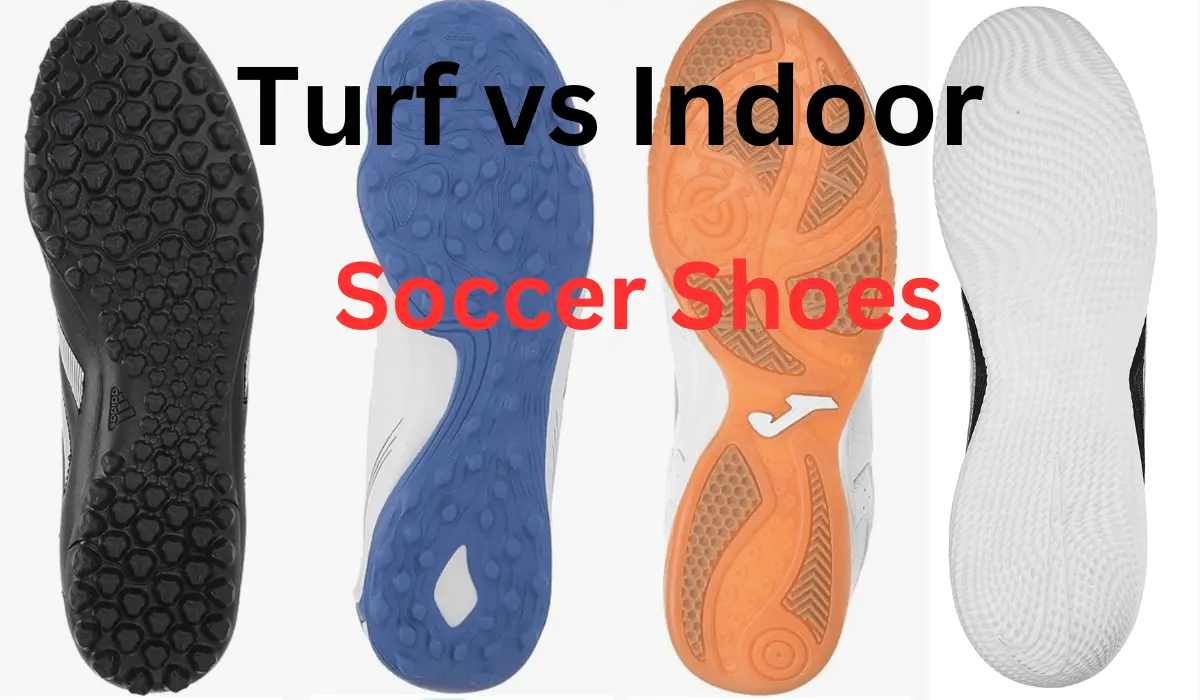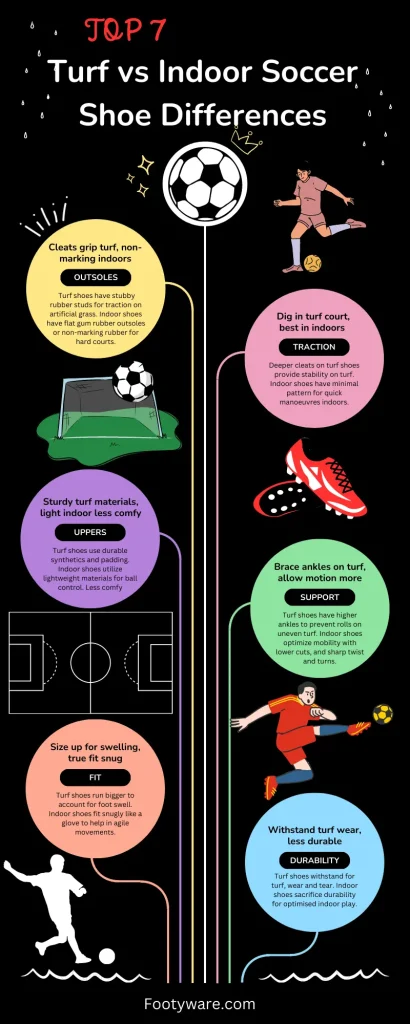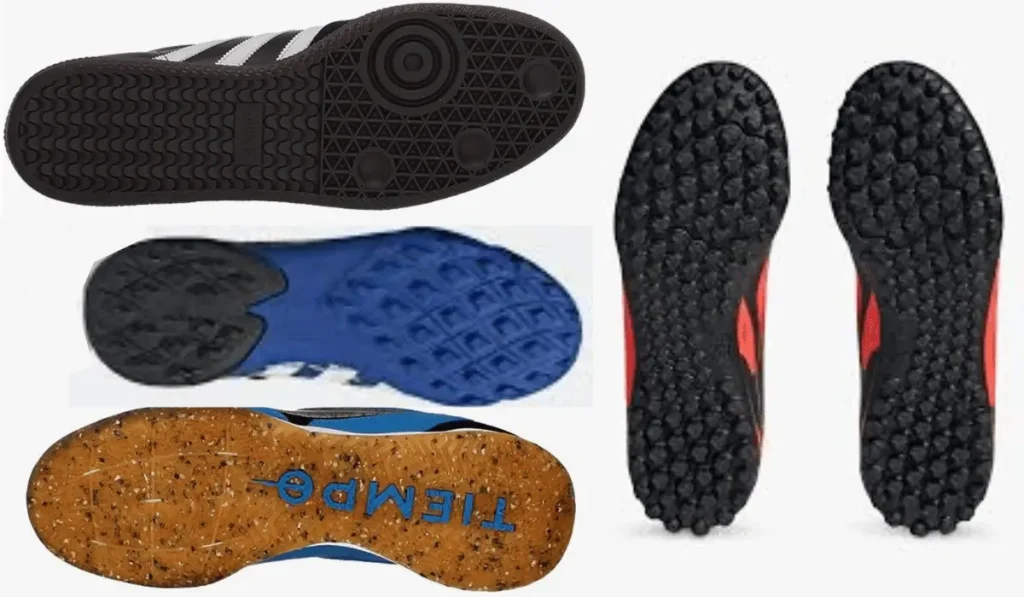Differences in Turf vs Indoor Soccer Shoes

“Remember that agonizing feeling of slipping and sliding during a crucial indoor match? Or maybe the frustration of clunky cleats digging into unforgiving artificial turf? Choosing the right footwear for your playing surface is crucial, and understanding the key differences between turf and indoor soccer shoes can transform your game.
While both share similarities like non-marking outsoles, their construction and performance cater to distinct environments. Turf shoes, like those designed for field turf, boast grippy rubber nubs or even deeper cleats for optimal traction on synthetic grass.
Futsal turf shoes, for instance, often feature a unique dimpled outsole for superior control and quick turns. Meanwhile, indoor shoes prioritize lightweight agility on hard surfaces like polished concrete courts. Imagine weaving through defenders like a futsal legend with shoes specifically designed for lightning-fast cuts and pivots.
But it’s not just about traction. Turf shoes typically have sturdier synthetics and padding to withstand the abrasiveness of artificial grass, while indoor shoes prioritize a snug, lightweight fit for enhanced ball control and quicker movements.
As a seasoned indoor player myself, I swear by shoes that feel like an extension of my feet, allowing for precision touches and rapid accelerations. Trust me, the difference between clunky boots and feather-light agility shoes is a game-changer.
Of course, finding the perfect fit is crucial. While turf shoes often run slightly larger to accommodate feet swelling during play, indoor shoes should hug your foot like a second skin.
Remember, the wrong footwear can not only hinder your performance but also lead to injuries. Don’t be like me in that fateful indoor tournament where borrowed turf shoes turned every step into a comedy of errors!
Ultimately, whether you’re a turf warrior dominating the synthetic pitch or an indoor maestro weaving magic on the hard court, choosing the right shoes is an investment in your game. So, lace up with confidence, knowing your footwear is your trusted ally on the path to soccer glory!”
Turf vs. Indoor Soccer Shoe Differences
The table above highlights several key differences between indoor soccer shoes designed for artificial turf versus indoor soccer court surfaces. Starting from the ground up, turf and indoor shoes differ most notably in their outsole traction and tread patterns.
Turf shoes utilize short, molded rubber or synthetic studs to reliably grip the turf-like synthetic fibers of artificial fields. The nubs dig into the turf pile to prevent slipping during sharp turns, accelerations, and sprints.
Indoor soccer shoe outsole is of gum rubber that allows smoother pivots and maneuvers on polished hardwood or court floors where minimal traction is ideal due to the hard flat and shiny surfaces you can run back and forth easily.

Moving up, turf and indoor shoes vary in their upper materials and construction. Turf shoes emphasize durability and protection for prolonged play on abrasive artificial grass. Uppers feature padded synthetic leather or textile overlays in high-wear areas.
Indoor soccer shoes prioritize the lightweight breathability and feel of the ball, utilizing thin synthetic leather or knit mesh uppers.
Ankle collars also differ, with turf shoes providing added coverage and support for unstable turf courts while indoor shoes for soccer maximize mobility with lower-cut designs ideal for quick runs and direction changes on flat indoor surfaces.
In terms of fit and sizing, turf shoes often run bigger to account for foot swelling during play while indoor shoes fit snugly true to size and give you the ultimate grip you can imagine.
There are also performance differences, with turf soccer shoes better suited for sprints and sharp twists and turns on turf and soccer shoes for hard court are ideal for fast-twitch indoor play.
Turf shoes offer better durability for rough conditions even outdoors but indoor soccer shoes provide superior court traction and ball control indoors optimally.
Safety and cost also come into play, with the sturdier turf shoes able to prevent slipping on artificial fields or turf but at a higher price point than basic indoor soccer shoes having flat outsole which works best on hard wooden courts.
Turf and indoor soccer shoes are engineered for their respective playing surfaces. While they may look similar from their upper their outsole is different.
Outsole and its Types
The outsole is the bottom of the shoe that contacts the ground.

- Turf Shoes – Have a flat, evenly spaced pattern of small nubs to provide traction on artificial turf. These nubs are made of durable rubber or plastic. The rubber buds underneath give you firmness and stability on the turf while playing soccer.
- Indoor Shoes – Have non-marking rubber underneath that is in a proper pattern to allow you for quick twists and pivots on flat indoor surfaces. The studs are smaller with more flex grooves for indoor maneuverability and quick movements.
Ankle Support
- Turf Shoes – Tend to have higher ankles and added support since playing surfaces are less consistent outdoors. The added ankle coverage protects against rolled ankles. Due to high ankle support, they’re a little weighted.
- Indoor Shoes – Typically have low ankle collars for maximum mobility and sharp turns during the match. Indoor soccer courts provide consistent firmness and even surfaces so less support is needed, and also the weight of indoor soccer shoes is less which helps you in sharp movements.
Size Difference
- Turf Shoes – These are often roomier to accommodate feet swelling during extended soccer on turf. Half size up from your regular shoe size is common because shoes get heated and can damage your skin.
- Indoor Shoes – These are sized more snugly since less movement occurs indoors. Your regular shoe size or half size down because you need to do instant movements back and forth which is the need of the game.
Comfortability Level of Both
- Turf Shoes – Feature thick insoles and padded tongues for comfort during prolonged soccer games. You need to have comfy footwear to continue with the game and enjoy it in the best possible way.
- Indoor Shoes – Have thinner insoles focused more on responsiveness than cushioning for indoor agility. Less padding is needed for shorter indoor games because you need to do instant movements.
Snug Fit or Not?
- Turf Shoes – Have a looser fit in the forefoot for toe ease during runs of turf to feel breathable and flexible. Midfoot is held snugly in place.
- Indoor Shoes – Engineered for a glove-like fit throughout the entire foot for quick cuts and turns on indoor surfaces and make your opponents pay before they get to know your movements.
Good for Running or Not?
- Turf Shoes – The studded outsoles provide good traction for sprints, pivots, and changes of direction on different surfaces like turf, firm ground, or even dry grass like usually in winter so you can use them for running on these surfaces but on roads for long because they’ll damage both your shoes and your muscles.
- Indoor Shoes – Lower profile outsoles allow an excellent court feel but are not ideal for sustained running outdoors.
How Durable they’re
- Turf Shoes – Made of synthetic leather or mesh upper materials that can resist harsh conditions and high wear areas. Outsoles hold up well on abrasive turf and can be used even in outdoor activities.
- Indoor Shoes – Have soft synthetic leather uppers for lightweight but sacrifice some durability. Indoor outsoles withstand court friction but wear down on the turf and other rigorous surfaces because they’re made for shiny wooden courts.
Safety of Both Shoes
- Turf Shoes – Sturdier construction provides protection while playing on turf indoors or outdoors. Studs optimize traction to prevent slipping.
- Indoor Shoes – Very flexible with minimal foot protection. Non-marking rubber pattern provides a smooth grip on gym floors and other shiny and plain surfaces.
Material Used in Turf and Indoor Soccer Shoes
- Turf Shoes – Utilize hardy synthetic leathers, densely layered mesh, and durable outsole have rubber buds underneath.
- Indoor Shoes – Lightweight synthetic leather or knit uppers with gum rubber outsoles or non-marking patterns optimized for indoor use.
Types of Indoor Soccer Shoes
Indoor soccer is played on a variety of hard, smooth surfaces ranging from polished wood to shining courts like basketball courts. With dynamic indoor gameplay requiring quick twists and turns, instant accelerations, and ball control, shoes must provide optimal traction and responsiveness.
There are three main types of footwear engineered specifically for the fast-paced indoor game.
Court shoes have a lightweight upper and non-marking rubber outsole suited for basketball courts and other flat indoor surfaces. The minimalist tread pattern offers flexibility and the best feel.
Futsal shoes are designed for the hard indoor surfaces used in futsal, an offshoot of soccer played with a smaller, heavier ball. They have soft leather uppers and a flat gum rubber sole for optimal indoor ball control.
Sala shoes are the lightest option, built for the 5-on-5 indoor soccer variant called sala. With an ultra-thin upper and minimal indoor rubber sole, they maximize quick bursts of acceleration needed in the tight spaces of indoor soccer arenas.
While preferences vary, all indoor soccer shoes aim to provide the responsiveness, grip, and freedom of movement needed for the indoor game in compact confines through purpose-built designs and materials quality materials used specifically for the gym, court, or arena surface.
Court Indoor Soccer Shoes
Court soccer shoes have a low-profile rubber outsole with multipurpose indoor court traction pads spread evenly across the bottom.
They provide great grip for quick turns and maneuvers on flat, shiny courts, gym floors, or indoor turf.
Futsal Shoes
Futsal is a variant of indoor soccer played on a basketball court-sized hard surfaces that can be wooden or concrete but polished. Futsal shoes are designed specifically for this type of indoor soccer.
Turf Soccer Shoes
Sala is a high-paced form of indoor soccer. Sala shoes are the most lightweight indoor soccer footwear.
What’s Turf and Turf Shoes?
Turf refers to artificial grass playing fields that are used for many sports, including soccer both indoors and outdoors. The synthetic blades of plastic turf are filled with infill materials like small rubber pieces for cushioning and grip.
Turf shoes are designed for optimal performance and traction on these artificial playing surfaces.
Some features of turf soccer shoes include:
The studded outsoles allow quick acceleration and changes of direction on turf fields. The sturdy construction handles the rigors of prolonged play on the artificial surface. Turf soccer shoes provide the grip, stability, and durability needed for indoor and outdoor soccer games on turf.
Types of Surfaces for Indoor Soccer
Indoor soccer is played on a variety of hard court surfaces:
Wooden Floors
Indoor arenas choose polished hardwood, especially maple, for its lightning-fast play. The hard surface rockets the ball down the pitch, keeping the pace very fast. These glossy floors shine, but these are bad for knees and joints from harsh contact.
While maple ranks strongest for durability under regular indoor use, it shows no mercy to fallen players. Their thin gum rubber outsoles stick and pivot without scuffing the floor’s sheen.
Still, wood requires meticulous care. Damp mop with designated cleaners to avoid warping or water damage. Watch for “dead spots” where boards lose flex and reform. Though labor-intensive, properly cared-for maple endures decades of fast and furious indoor soccer.
Sport Court Tiles
Indoor soccer arenas often utilize interlocking court tile surfaces for their seamless floors that enable rapid ball movement. However, the slick tiles require players to wear specialized shoes for sufficient traction.
For optimal safety, install shock-absorbing polypropylene rubber tiles that flex on impact to disperse force and reduce strain. Adding padded underlay below the tiles offers an unparalleled cushioning system, absorbing blows and improving traction.
This underlay also boosts the tiles’ durability and impact resistance. Together, the stability-enhancing tiles and protective underlay provide premier playability and safety. Additional benefits include suitability for all weather, easy cleaning, moisture and bacteria resistance, and shock absorption.
This combination of high-performance turf and padded underlay is the ultimate solution for indoor arenas seeking safety, durability, and low maintenance.
Artificial Turf for Indoor Arena
To bring outdoor field conditions inside, some facilities install synthetic turf over their hardcourt floors. With less infill than outdoor artificial grass, the turbocharged surface stays fast-paced for indoor play.
Shoes need balanced traction for the unique turf over the court. Artificial turf offers major advantages over natural grass for indoor arena use. Maintenance is easy – no watering or moping is needed! The consistent green polyethylene fiber and inlaid lines look great year-round regardless of the weather.
Rubber infill improves grip. Compared to grass, artificial turf enjoys superior durability, lasting 8-10 years with heavy use. For additional comfort, padded turf can cushion falls and absorb hits.
With its gameplay speed and low maintenance, artificial turf over indoor courts provides an ideal alternative to grass at a fraction of the upkeep.
Multipurpose Gym Floors
School gyms and recreation centers are common venues for indoor soccer, often outfitted with polyurethane floors. While polyurethane coatings offer some baseline traction suitable for indoor play, these smooth floors collect dust, dirt, and debris over time.
Regular cleaning before games is crucial to maximize traction and prevent slipping. Areas near the sidelines and center court tend to become slick from players stopping and pivoting in those high-traffic zones.
Mopping with a diluted vinegar solution helps remove grime and restore grip across the entire court. Glossy sealants can also reduce traction – matte or lightly textured finishes are ideal for shoe grip.
Facilities can improve safety by replacing standard polyurethane with poured rubber surfacing or multi-purpose court tiles if the budget allows. However, with diligent cleaning and proper footwear, standard polyurethane floors can be made game-ready.
Consult with your gym or rec center staff to establish optimal cleaning routines for indoor soccer safety.
Can you wear turf shoes on an indoor soccer field?
Turf soccer shoes can be worn indoors but they are not ideal for indoor soccer courts and may increase injury risk. The studded outsoles of turf shoes are designed for digging into and releasing from thick artificial grass.
On flat, hard indoor surfaces, the prominent studs feel clunky and lack flexibility. Traction suffers, as the studs cannot penetrate to grip the floor. So it’s better to have specific shoes for specific surfaces and games. You’ll have optimal enjoyment.
The molded studs of turf shoes also collect dust and debris easily, reducing traction as the game goes on. The higher ankles and wider fit feel restrictive during quick indoor moves. Turf soccer shoes are durable for turf surfaces whether indoors or outdoors but feel stiff and cumbersome indoors.
Their thick soles do not provide a proper board feel or court grip. For performance and safety, shoes designed specifically for indoor soccer are recommended. So it’s better to wear indoor soccer shoes for indoor soccer has flat outsoles of non-marking rubber patterns.
Can you wear indoor soccer shoes on the turf?
Indoor soccer shoes can technically be used on artificial turf fields but they are not ideal and have some drawbacks compared to true turf shoes. The blade-style studs on indoor shoes do not effectively penetrate and release from thicker turf carpets.
Grip suffers, increasing risks of slips and falls. If you lose grip then what’s the purpose of wearing shoes? So better to use shoes that’re recommended for specific surfaces.
The soft gum rubber compounds of indoor outsoles also wear down quickly on abrasive turf. Without defined traction, cuts and acceleration are affected. The flexible low-ankle construction offers less support and protection on uneven turf.
While top players may get by with indoor shoes on turf for short games, they sacrifice stability, durability, and ankle support compared to turf-specific shoes. Turf shoes are engineered to anchor in the turf carpet and withstand the rigors of prolonged outdoor play.
Can Standard Soccer Cleats Be Used On Turf?
Many soccer players wonder if traditional firm ground cleats with long, conical studs can be worn on artificial turf fields. The short answer is yes, you can use standard molded soccer cleats on turf occasionally.
I have also used Adidas Samba Classic indoor soccer shoes on turf but after a proper warmup and still, after the game I felt stiffness in my calf muscles and pain in my thighs too. However, there are some distinct disadvantages compared to turf-specific shoes:
- The long studs feel unstable and can get caught in the thicker turf carpet leading to ankle rolls or knee twists.
- Natural grass cleats lack the smaller rubber buds on the sole edges that turf shoes have for additional grip and stability.
- The pointed studs on firm ground cleats wear down quickly and lose traction on abrasive turf.
- Without a flat outsole area, standard cleats offer less surface contact for weight-bearing control.
- Firm ground cleats drain poorly and get bogged down in wet, compacted turf.
While periodic turf use won’t immediately ruin them, over time the studs and uppers on conventional soccer cleats will break down.
For improved stability, traction, and durability, soccer shoes made specifically for artificial turf are a wise choice for players who regularly use these fields.
What To Look For In Turf Indoor Soccer Shoes
When shopping for indoor soccer shoes to use on both artificial turf and indoor courts, there are key features to look for:
- Hybrid Outsole Tread – Look for turf shoes that add shallow indoor blades to the traditional turf studs for dual surface traction.
- Stiffer Midsole – A firmer midsole provides stability on the turf while still being responsive for indoor cuts.
- Low-Profile Toe – A shallow, nimble toe design maintains close ball control indoors.
- Reinforced Upper – Durable synthetic leather and a reinforced toe bumper handle tough outdoor use.
- Partial Ankle Collar – A moderate ankle cut allows decent mobility indoors while protecting ankles on turf.
- Versatile Fit – Find a snug midfoot with a little extra forefoot room to accommodate swelling for extended outdoor wear.
Prioritizing versatile traction and fit will allow you to maximize your performance safely on both turf and indoor surfaces with one durable shoe. Think of hybrid versatility when selecting your next pair of turf indoor soccer shoes.
Conclusion of Turf vs. Indoor Soccer Shoes
Those early days of turf tumbles and indoor ice skating – yeah, we’ve all been there. But choosing the right soccer shoes isn’t just about saving face (though that’s a bonus). It’s about unlocking your full potential, whether you’re a turf warrior battling synthetic jungles or an indoor maestro weaving magic on polished courts.
Turf and indoor shoes are like specialized weapons for distinct battlegrounds. Turf titans need trusty cleats or grippy nubs to conquer dense blades, while futsal fiends rely on dimpled outsoles for control and quick turns. Indoor assassins, on the other hand, crave lightning-fast footwork, wielding minimally treaded soles that dominate smooth surfaces.
Hybrid options exist, offering versatility, but for peak performance, dedicated pairs often reign supreme. Turf shoes, slightly roomy for game-time swelling, meet the demands of the rougher terrain. Indoor shoes, snug and responsive, become an extension of your foot for precision and explosive movements.
Remember, ill-fitting footwear can sideline even the most skilled players – a lesson learned the hard way in a certain fateful indoor tournament (shudder).
“Turf-specific shoes took my game to fast-forward,” says Malik, a turf league striker. “Grip and stability on those cuts and turns? Unreal.”
Indoor maestro Maria echoes the sentiment: “Lightweight feel and responsiveness? I feel like I’m dancing on the court, not just playing.”
So, turf titan or indoor wizard, choose wisely. Your shoes should empower every step, every touch, every goal. Lace up with confidence, own the pitch, and let your skills reign supreme! The rest, as they say, will come naturally.
